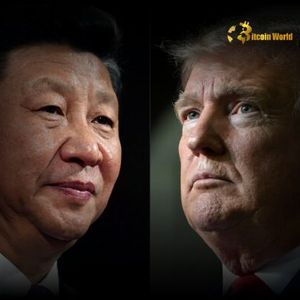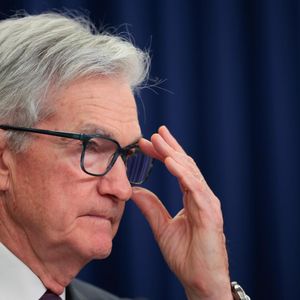Asia FX Reacts: Crucial US China Talks & Yen’s Stunning Dip Despite BOJ Rate Hike Pledge
5 min read
BitcoinWorld Asia FX Reacts: Crucial US China Talks & Yen’s Stunning Dip Despite BOJ Rate Hike Pledge For anyone tracking the global financial landscape, especially those with interests in the interconnected world of cryptocurrencies and traditional finance, understanding major currency movements is key. Currently, the focus is sharply on Asia FX , which finds itself navigating a complex environment shaped by geopolitical discussions and central bank actions. Let’s dive into the factors keeping Asian currencies under pressure and the intriguing case of the Japanese Yen. What’s Keeping Asia FX Subdued? The mood across Asian foreign exchange markets has been notably cautious. Several factors contribute to this subdued sentiment, preventing a broad upward movement for regional currencies: Global Economic Uncertainty: Lingering questions about the pace of global economic recovery and potential slowdowns in major economies weigh on risk appetite. Strength of the US Dollar: The US dollar’s performance remains a significant driver. When the dollar is strong, it typically puts pressure on emerging market currencies, including those in Asia. Interest Rate Differentials: The gap between interest rates in Asian economies and those in the US and other major regions influences capital flows, impacting currency valuations. Geopolitical Developments: Events like trade discussions and international relations play a crucial role in shaping investor confidence in regional assets. The Influence of US China Talks A major overhang for Asia FX is the ongoing dynamic between the United States and China. Any dialogue, negotiation, or tension between these two economic giants sends ripples across global markets, particularly affecting Asia due to its deep trade and economic ties with both nations. These US China talks , whether focused on trade, technology, or other strategic areas, create uncertainty that prompts investors to adopt a wait-and-see approach, dampening enthusiasm for riskier Asian currencies. Think of it this way: clarity on US-China relations can boost confidence and potentially lead to stronger investment flows into Asia, supporting local currencies. Conversely, signs of friction or stalled progress can trigger risk aversion, leading to capital outflows and currency depreciation. The current phase of talks appears to be keeping markets guessing, contributing directly to the subdued tone in Asia FX. Understanding the Japanese Yen’s Performance Perhaps one of the most discussed currency puzzles recently has been the behavior of the Japanese Yen . Despite increasing signals and even explicit pledges from the Bank of Japan (BOJ) about moving away from its ultra-loose monetary policy, potentially including a BOJ rate hike , the Yen has struggled to strengthen significantly, and has even dipped at times. Why is this happening? Here are key reasons: Yield Differentials Still Wide: Even with the prospect of a BOJ rate hike, interest rates in Japan remain substantially lower than in the US and many other developed economies. This wide gap makes the Yen less attractive for investors seeking higher returns on their deposits or bond holdings. The Carry Trade: The low-interest-rate environment in Japan has long fueled the ‘Yen carry trade,’ where investors borrow Yen cheaply and invest in higher-yielding assets elsewhere. As long as the yield differential is significant and market volatility is low, this trade remains profitable, keeping the Yen weak as investors sell it to buy other currencies. Pace of Hikes: While the BOJ is signaling a shift, the market expects the pace of future rate increases to be very gradual compared to the rapid hikes seen from other central banks in recent years. This expectation limits the potential for significant Yen appreciation based solely on monetary policy changes. Navigating the Broader Currency Market Landscape The dynamics in Asia FX and the specific situation with the Japanese Yen are part of a larger, interconnected Currency Market . Several global factors interact to influence these currencies: Federal Reserve Policy: The US Federal Reserve’s decisions on interest rates and quantitative easing remain paramount. A hawkish Fed generally strengthens the dollar, impacting all other currencies. Commodity Prices: Many Asian economies are significant importers or exporters of commodities. Fluctuations in oil, metals, or agricultural prices can affect trade balances and currency values. Regional Economic Data: Inflation rates, GDP growth figures, trade balances, and employment data from major Asian economies like China, South Korea, and others provide crucial signals about economic health and currency outlooks. Understanding these interwoven factors is essential for predicting potential currency movements. The current subdued state of Asia FX reflects a complex interplay of global uncertainty, US-China relations, and specific central bank policies like the anticipated BOJ rate hike . What Should Investors Watch For? Given the current environment, what are the key signposts to monitor? Outcomes of US China Talks: Any concrete progress or deterioration in discussions will have immediate market reactions, particularly impacting the Chinese Yuan and other currencies closely tied to trade with the two nations. BOJ’s Next Steps: While a rate hike is expected, the timing and the language used by the BOJ regarding future policy normalization will be critical for the Japanese Yen . Watch for shifts in forward guidance. Federal Reserve Signals: Any unexpected hawkish or dovish turns from the US Fed could significantly alter the trajectory of the US dollar, thereby influencing all Asia FX pairs. Economic Data Releases: Pay close attention to inflation and growth data from major Asian economies, as these will provide insights into domestic economic strength and potential central bank responses. Conclusion: A Delicate Balance for Asia FX In summary, Asia FX is currently treading water, caught between global economic crosscurrents and the specific uncertainties arising from US China talks . The Japanese Yen presents a unique case, where the prospect of a BOJ rate hike is being counterbalanced by persistent yield differentials and carry trade dynamics. The broader Currency Market remains sensitive to policy decisions from major central banks and evolving geopolitical landscapes. Navigating this environment requires a careful watch on these interconnected factors, as they will determine the path forward for Asian currencies. To learn more about the latest Forex market trends, explore our article on key developments shaping Currency Market liquidity. This post Asia FX Reacts: Crucial US China Talks & Yen’s Stunning Dip Despite BOJ Rate Hike Pledge first appeared on BitcoinWorld and is written by Editorial Team

Source: Bitcoin World



